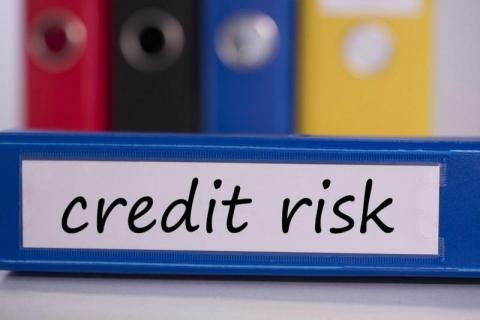
Credit Risk
- In simple terms, the likelihood of a loss arising from a borrower's failure to repay a loan or meet contractual commitments is referred to as credit risk.
- It means there will be a risk that a bank/ financial institution will not be able to obtain the amount of principal and interest from the borrower which will result in cash flow issues and higher collection costs for the bank/ financial institution.
- There is a risk of the borrower not repaying the debt when banks and financial institutions give housing loans, mortgages, credit cards, or other sorts of loans like corporate loans, and project loans. Similarly, if an organization extends credit to a customer, the customer may default on their payments.
- Credit risk also refers to the possibility that a bond issuer will default on a payment or that an insurance company will be unable to pay a claim.
Factors of credit risks include:
Credit default risk
When a borrower is unable to pay the loan obligation in full or has already missed the loan payback deadline by 90 days, credit default risk exists. All financial transactions which are credit-sensitive, such as home/ car loans, securities, etc. may be affected by credit default risk if the borrower fails to pay them back.
Concentration risk
Concentration risk refers to the risk posed by exposure to a single counterparty or sector, and it has the potential to result in huge losses that could jeopardize the lender's main operations. The danger arises from the fact that highly concentrated portfolios lack diversification, resulting in more linked returns on the underlying assets.
Sovereign/ Country Risk
Country risk is the possibility that a country will default on its debts if it freezes its foreign currency payments obligations. The risk is linked to the country's political unrest and poor macroeconomic performance, both of which could have a negative impact on the value of its assets and operating profitability. Changes in the business environment could have a drastic impact on all businesses in a given country.
Credit Risk Management
Credit risk management is a technique used by financial organizations to reduce or eliminate credit risks in their loan portfolio. Set up credit approving authority, risk rating, portfolio's credit risk management, risk pricing, stringent cash flow analysis, cash flow projection analysis, industry risk factor analysis, management background factor analysis, and loan review processes are some of the mechanisms and strategies lenders might use.
Market Risk
- Market risk refers to the probability that an individual or other entity would lose money as a result of factors that impact the overall performance of financial market investments.
- Diversification cannot remove market risk, often known as "systematic risk," but it can be mitigated in various ways.
- Recessions, political turbulence, interest rate changes, natural disasters, and terrorist acts are all sources of market risk. Systematic risk, often known as market risk, affects the entire market at the same time.
- Market risk exists as a result of price fluctuations. Price volatility is defined as the standard deviation of movements in the prices of stocks, currencies, or commodities.
- Volatility is measured in annualized terms and can be stated as a fixed amount, such as Rs. 30, or as a percentage of the beginning value, such as 20%.
Types of Market Risk
Interest Rate Risk
Interest rate risk is caused by unanticipated changes in interest rates as a result of monetary policy actions conducted by the central bank. In the long run, market demand and supply of the instrument must be adjusted to equalize the yields offered on securities across all markets. As a result, an increase in rates would result in a decrease in the security price. It's mostly related to fixed-income investments.
Commodity Risk
Certain commodities, such as oil or food grain, are essential for any economy and, because they are used as indirect inputs, they complement the manufacturing process of numerous goods. Any fluctuation in commodity prices has a cascading effect on the performance of the entire market, frequently resulting in a supply-side crisis. Stock prices and performance-based dividends fall as a result of such shocks, and a company's capacity to uphold the principle value falls as well.
Currency Risk
Exchange rate risk is another name for currency risk. It refers to the likelihood of a decrease in the value of an investor's return due to the depreciation of the native currency's value. When making an international investment, the risk is frequently taken into account. Many emerging market economies keep large foreign exchange reserves to ensure that any probable devaluation may be offset by selling the reserves, reducing the risk of losing out on foreign investment.
Market Risk Management
As mentioned in the Guidance Note on Market Risk Management for banks released by the RBI, all banks should follow the below guidelines:
Policy Framework - All banks should establish specific policies on market risk management. The policies should represent minimum requirements for the bank including approval levels and requirements for any exceptions, deviations or waivers.
Organisational Set-Up - the organization set up for Market Risk Management should include The Board of Directors, The Risk Management Committee, The Asset-Liability Management Committee (ALCO), and The ALM support group/ Market Risk Group. The Board of Directors should have the overall responsibility for the management of risks.
Further, the guidance notes also explain topics on Liquidity Risk Management, Interest Rate Risk Management, Foreign Exchange Risk Management, The Treatment of Market Risk in the Proposed Basel Capital Accord, Value at Risk, and Stress Testing among other areas.
Source of Market Risk Management - https://rbidocs.rbi.org.in/rdocs/notification/PDFs/27560.pdf
